Loyalty points programs: A crash course in loyalty rewards (with examples)
A carefully crafted loyalty points program doesn't just encourage repeat purchases through tempting rewards; it forges lasting connections that keep customers coming back time and again.
In this blog, we'll explore the ins and outs of creating, launching and maintaining a loyalty points program that not only delights your clientele but also delivers measurable benefits to your bottom line.
Skip to:
Discover our B2B loyalty points platform in just 3-mins
Watch a quick platform demo online now.
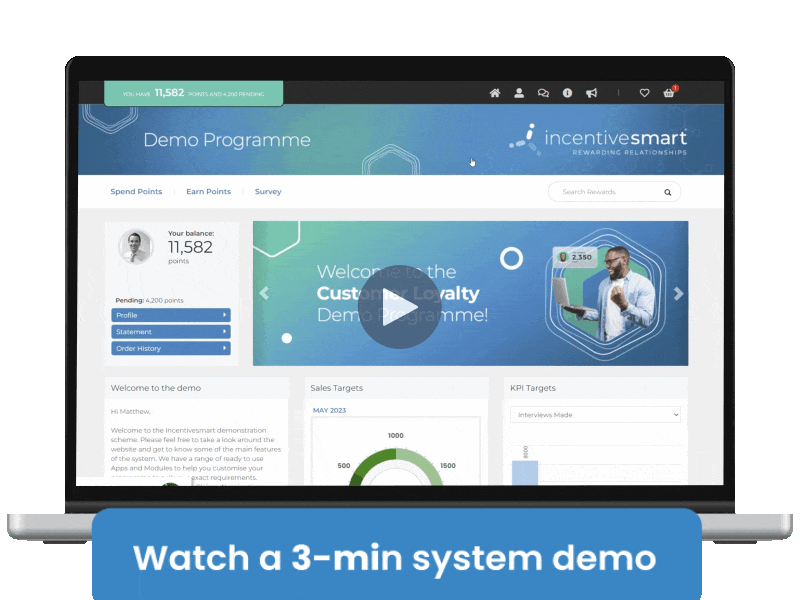
What are loyalty points?
Loyalty points are a method used by businesses to encourage customers to repeat purchase with the prospect of earning reward points on each purchase.
When a customer buys things or takes certain actions - like signing up for a newsletter or referring a friend - they earn these points. And over time, they add up and can be used in exchange for merchandise, discounts, gift cards, freebies or other perks.
Points-based loyalty schemes are popular in various industries like retail, hotels, airlines, credit cards and online ecommerce stores. The idea is to reward customers for sticking with the company, rather than shopping with competitors.
By offering loyalty rewards, businesses hope to move away from one-time transactional relations and build a strong bond with their customers (otherwise known as ‘customer loyalty’). It’s a way of saying 'thank you' for their support and keeping them engaged with the brand. In turn, they’ll choose your products or services over others.
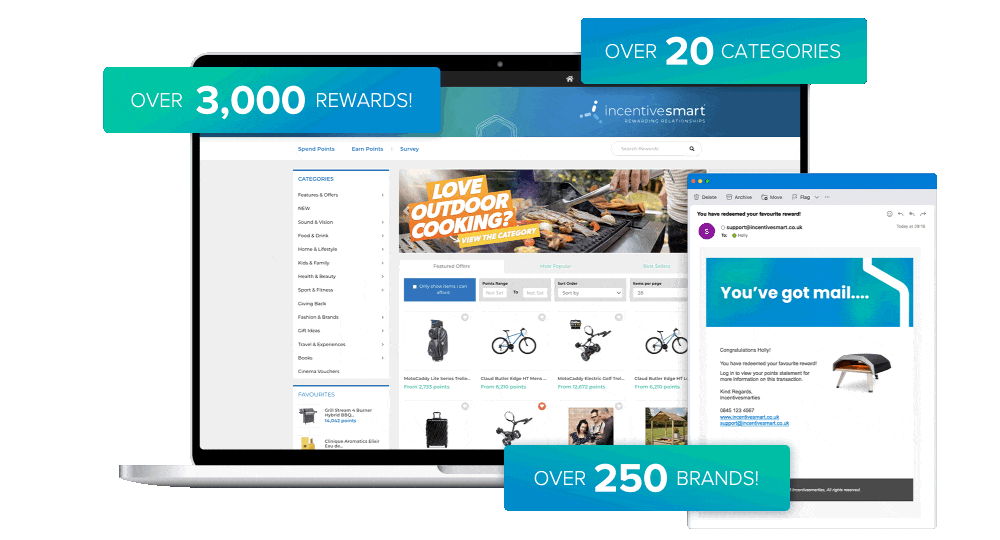

Why use loyalty points? (over other loyalty reward structures)
Loyalty points systems are favoured by businesses for many compelling reasons, often making them a preferred choice over alternative loyalty reward structures. There are various benefits to be taken into account, including:
- Flexibility: Loyalty points offer flexibility both for customers and businesses. Customers can accumulate points over time and redeem them for rewards that suit their preferences. For businesses, this system allows them to offer a wide range of rewards without committing to specific discounts or incentives upfront.
- Customisation: Loyalty points systems can be tailored to fit the needs and goals of a specific business. Companies can adjust earning rates, redemption options and bonus promotions based on their target audience and product offerings.
- Retention: By rewarding customers for their repeat business, companies encourage customers to remain loyal and advocate for their products or services. This helps to reduce customer churn, increase lifetime customer value and drive in referred prospects.
- Data collection: Loyalty points programs provide businesses with valuable data about their customer's preferences, purchasing habits and engagement patterns. This data can be used to segment customers, personalise marketing efforts and improve overall customer experience.
- Competitive advantage: Offering a loyalty points program can differentiate a business from its competitors and attract new customers. Customers are often drawn to brands that provide additional value through rewards and incentives, giving businesses a competitive edge in the market.
- Psychological impact: The accumulation of loyalty points can create a sense of progress and achievement for customers, encouraging them to continue earning points and reaching higher reward tiers. This psychological effect can foster stronger emotional connections between customers and the brand.


How much are loyalty points worth?
In most cases, loyalty points hold a monetary value, meaning they can be exchanged for goods within a catalogue, discounts in store, free products/upgrades or other perks. However, the worth of loyalty points can vary significantly depending on the specific program, as companies can define this value upon launch.
| For instance, in a retail loyalty program, customers might earn 10 points with each purchase and these points could eventually be redeemed for vouchers or discounts on future purchases. The value of each point might be fixed, such as 1 point equaling £0.01 or it could fluctuate based on promotions or special offers. |
In airline or hotel loyalty programs, the value of points can be more complex.
Points might be redeemable for flights, hotel stays, upgrades or even experiences like concert tickets or dining vouchers. The value of points in these programs can vary based on factors such as the destination, availability and demand.
| For example, redeeming points for a flight during peak travel season might require more points than during off-peak times. |
It's important for customers to understand how loyalty points are earned and how they can be used effectively. Keeping track of the value of loyalty points and understanding the redemption options can help customers make the most of their loyalty reward memberships.
Download your FREE GUIDE to B2B Customer Loyalty
Inside you will learn how to:
- Create long-term loyalty
- Define the stages of loyalty
- Design a B2B loyalty points program
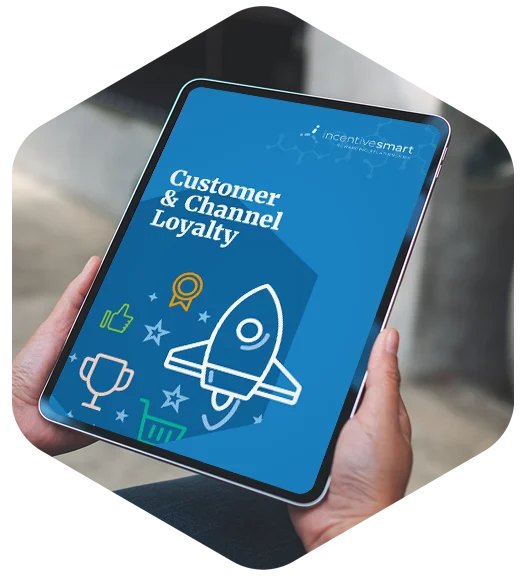
How to structure a point-based loyalty program
Creating a points-based loyalty program entails strategic planning and thoughtful deliberation. It’s essential to craft a system that not only motivates customer participation but also aligns with business objectives.
So let’s set the stage for a step-by-step exploration into program structure, by highlighting the importance of designing incentives that drive desired customer behaviours.
Here are some of the factors you need to consider when structuring a points-based loyalty program:
 Set clear objectives
Set clear objectives
It's crucial to kick things off by setting clear objectives. This means figuring out exactly what you want to achieve. Do you want to encourage customers to shop more frequently, spend more money, refer friends or stick around for the long term?
By defining these goals upfront, you can tailor your loyalty points mechanic to incentivise the specific behaviours you're targeting, which not only engages customers but also delivers tangible results for your business.
 Understand your customers
Understand your customers
Start by conducting thorough market research and analysing customer data to gain insights into your target audience's preferences and shopping behaviours.
This might involve gathering information on demographics, purchasing patterns, preferred communication channels and factors influencing brand loyalty.
In doing so, you can uncover valuable insights about what drives your customers' purchasing decisions and how they interact with your brand, which should help you tailor your rewards to resonate with their needs and interests.
| For example, if your research reveals that your customers value personalised experiences, you might consider offering tailored rewards or exclusive perks based on their individual preferences. Alternatively, if your target audience is price-sensitive, you might focus on providing discounts or incentives to encourage repeat purchases (but be wary of the negative spiral discounting can induce… incentives are far more likely to deliver positive results longer term). |
 Define reward point-earning opportunities
Define reward point-earning opportunities
This step is about identifying the specific actions or behaviours that customers can undertake to earn loyalty points.
These actions should be carefully chosen to resonate with your target audience and align with your business objectives. Common opportunities include; making purchases, signing up for memberships, referring friends, participating in surveys or reviews, engaging with your brand on social media or attending events.
By offering a diverse range of earning opportunities, you can ensure your loyalty point rewards are more inclusive and appealing to a wider range of customers, ultimately driving greater participation and engagement.
 Establish point value and tiers
Establish point value and tiers
Begin by defining the worth of each loyalty point and establishing how it corresponds to various rewards. This involves carefully considering the balance between the value of points and the attractiveness of the rewards offered. You may also want to offer bonus points for specific actions or purchases to further incentivise desired behaviours, such as making larger transactions or engaging with promotional activities.
Moreover, creating tiered membership levels based on accumulated points can enhance the effectiveness of your programme. By rewarding loyal customers with exclusive benefits and privileges as they progress through different tiers, you not only incentivise continued engagement but also foster a sense of status and recognition among your most dedicated patrons. These tiers can be designed to offer increasingly desirable rewards and perks, motivating customers to strive for higher levels of engagement with your brand.

 Communicate the program’s details clearly
Communicate the program’s details clearly
Transparency and clarity are key to fostering trust and encouraging active participation with your loyalty program, therefore, utilise a variety of communication channels to reach your audience and convey the program's benefits, such as:
- Website: Create a dedicated section on your website that outlines the key features of your loyalty reward offering. Provide clear and concise information about how customers can earn points, what rewards they can redeem and how they can track their progress.
- Email newsletters: Send regular email newsletters to your customer base to keep them informed about the latest updates and promotions. Highlight earning opportunities, exclusive offers and success stories from other members to encourage engagement.
- Social media: Leverage your social media platforms to raise awareness. Share engaging content that showcases the benefits of participation and encourages followers to join in. Respond promptly to customer enquiries and feedback to demonstrate your commitment to customer satisfaction.
- In-store signage: Place prominent signage in your physical store locations to inform customers. Use eye-catching visuals and concise messaging to capture their attention and encourage sign-ups.
- Mobile apps: If you have a mobile app, integrate information directly into the app interface. This allows customers to easily access details, track their points and redeem rewards while on the go.
 Implement tracking management systems
Implement tracking management systems
Implementing effective tracking and management systems lies at the heart of a thriving loyal customer community. Such systems oversee every aspect of the program's operations to ensure its smooth functioning and success.
By employing dedicated software tailored to manage loyalty initiatives and (even better) by integrating it into existing Customer Relationship Management (CRM) systems, businesses can elevate their loyalty experience.
These systems are multifaceted, adeptly tracking the accumulation of customer points, the process of redeeming rewards and the dynamic management of membership tiers.
| For instance, they monitor customer interactions, such as purchases, referrals, and engagement with promotional activities, accurately crediting points to their accounts. |
This not only eliminates manual tracking errors but also provides businesses with valuable insights into customer behaviour, allowing for more targeted and effective marketing strategies. Additionally, these systems play a pivotal role in managing membership tiers. They automatically track customer progress and assign appropriate tier benefits based on accumulated points or other qualifying criteria.
 Monitor performance
Monitor performance
Stay on top of your programme's performance by consistently monitoring various important metrics. These metrics include customer participation rates, trends in point accumulation and redemption, and the overall return on investment (ROI) of the programme. By analysing this data regularly, you can gain valuable insights into how effectively your programme is engaging customers and driving business results.
Monitoring trends in point accrual and redemption provides valuable insights into customer behaviour and preferences. You can identify which rewards are most popular among customers, as well as any patterns in how points are being earned and spent. This information can help guide decisions on adjusting reward offerings or introducing new incentives to better align with customer interests.
Assessing the ROI of your loyalty efforts allows you to evaluate financial performance and determine whether you are delivering a satisfactory return on your investment.
By comparing the costs associated with running the program to the revenue generated from increased customer retention and spending, you can gauge its overall effectiveness and make informed decisions about future investments.
Discover our B2B customer loyalty platform in just 3-mins
Transform occasional customers into loyal brand advocates.
Examples of loyalty points in action
We highlighted some exceptional loyalty schemes offered by top brands here. And below, you’ll find a few more case studies that have proven effective in engaging customers and enhancing brand loyalty over the last few years…
Retail loyalty rewards
Retail loyalty programs are instrumental in nurturing customer loyalty and encouraging repeat business within the retail sector. Several prominent examples include the Sainsbury's Nectar Card, Tesco Clubcard, and Boots Advantage Card.
 |
Sainsbury's Nectar Card stands as a cornerstone of the grocery retailer's loyalty efforts. This programme allows customers to earn Nectar points for purchases made not only at Sainsbury's but also at other participating retailers, including Argos and eBay. These points serve as a versatile currency, redeemable for discounts on future purchases, as well as a wide array of rewards and experiences available through the Nectar catalogue. |
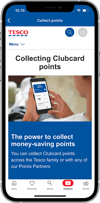 |
Tesco's Clubcard similarly offers customers the opportunity to earn rewards for their loyalty. With Clubcard points earned for every pound spent, whether in-store or online, customers can accumulate points quickly. These points can then be redeemed for discounts on future purchases, vouchers for partner brands, or even exchanged for rewards like restaurant meals or theme park tickets, providing customers with a range of enticing options. |
 |
Boots, a renowned pharmacy and beauty retailer, operates the Advantage Card loyalty program. This program rewards customers with points for every pound spent, allowing them to accumulate rewards with each purchase. These points can subsequently be redeemed for discounts on future purchases or exclusive offers on select products, enhancing the value proposition for Boots customers and encouraging continued patronage. |
Airline loyalty programs
Airline loyalty programs are essential tools for rewarding frequent traveler's and fostering customer loyalty within the competitive aviation industry. Two prominent examples include the British Airways Executive Club and the Virgin Atlantic Flying Club.
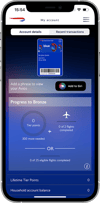 |
The British Airways Executive Club operates on a points-based system, where members earn Avios points for various travel-related activities, including flights, hotel stays, car rentals, and other purchases. These Avios points serve as a currency within the programme, offering members the opportunity to redeem them for a variety of rewards. This can include flights to numerous destinations, upgrades to premium cabins, hotel accommodations and other travel experiences. |
 |
Similarly, the Virgin Atlantic Flying Club offers loyalty points tailored to the needs of frequent flyers. Members earn Flying Club miles for flights with Virgin Atlantic and its partner airlines. These miles can be redeemed for a range of rewards, including flights to various destinations, upgrades to premium cabins for a more luxurious travel experience, hotel stays and other travel-related experiences. |

Fitness and wellness
Fitness and wellness rewards play a significant role in motivating individuals to maintain healthy lifestyles while fostering loyalty to specific gym chains or wellness centres. One such example is PureGym, a prominent gym chain in the UK.
PureGym's loyalty program, PureGym Plus, gives members the chance to earn points by attending classes, referring friends to join the gym and even achieving personal fitness milestones. The rewards available include complimentary gym passes, allowing members to bring guests or access additional facilities beyond their regular membership. Alternatively, members may have the option to exchange their points for exclusive merchandise, such as branded apparel or fitness accessories. Moreover, PureGym Plus may offer discounts on supplementary services or amenities, such as personal training sessions, nutritional consultations or specialised fitness classes.
Need help creating a points-based loyalty reward program?
With our extensive experience in B2B points programs, we specialise in creating tailored loyalty reward programs to suit the needs or trade-focused businesses. Whether you wish to boost customer retention, increase sales or enhance brand loyalty, our team is here to help.


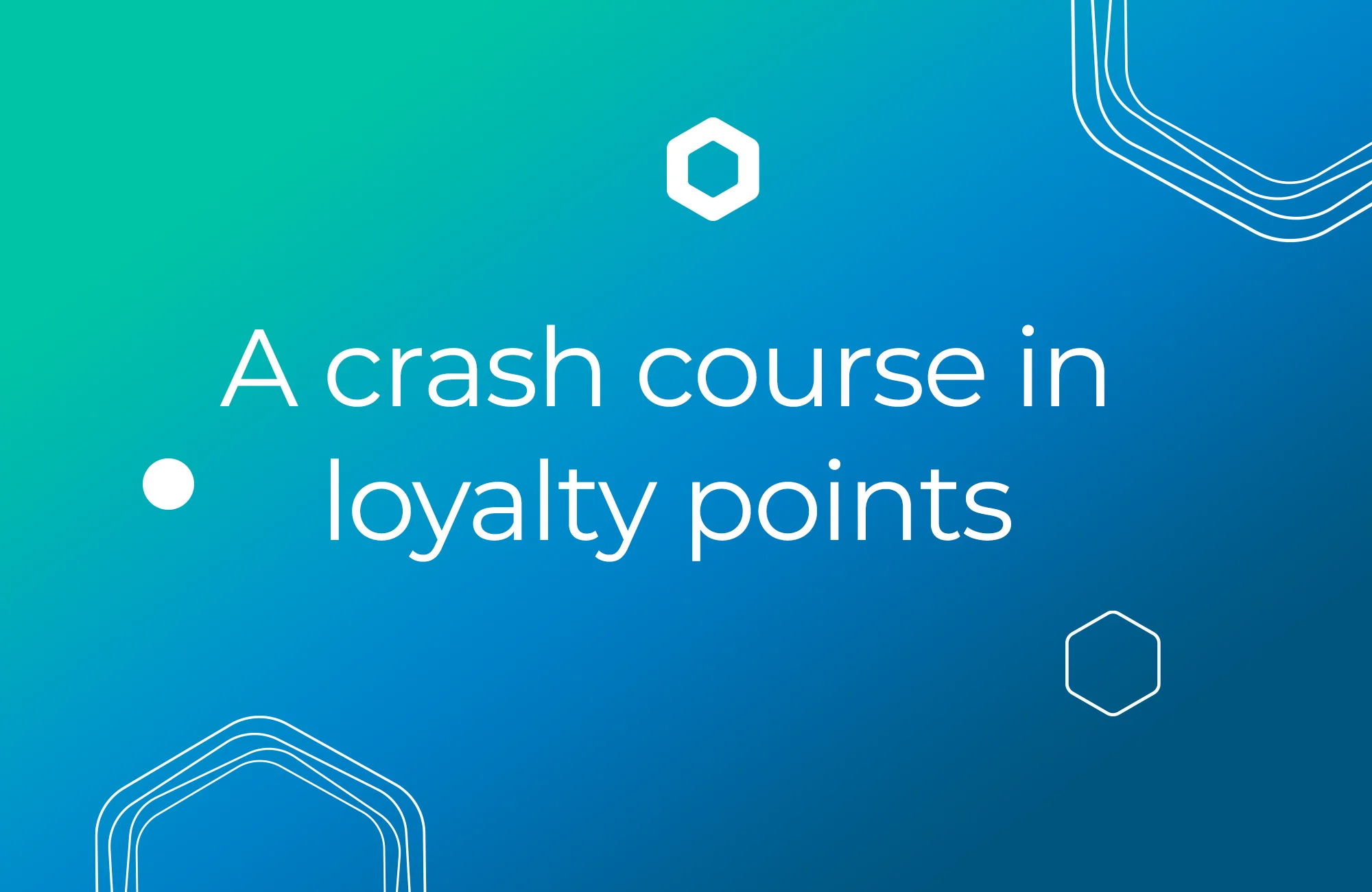









Join the discussion